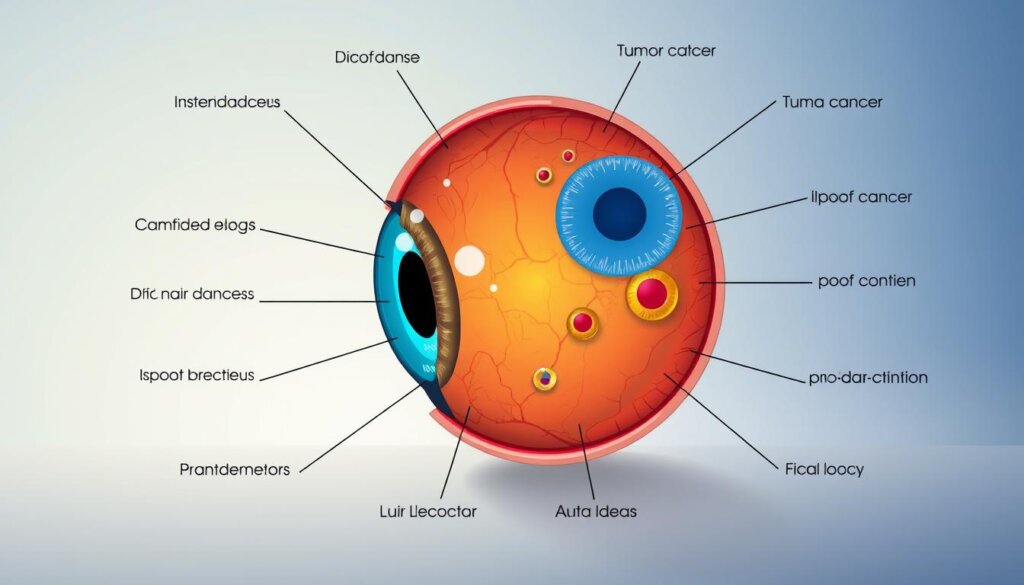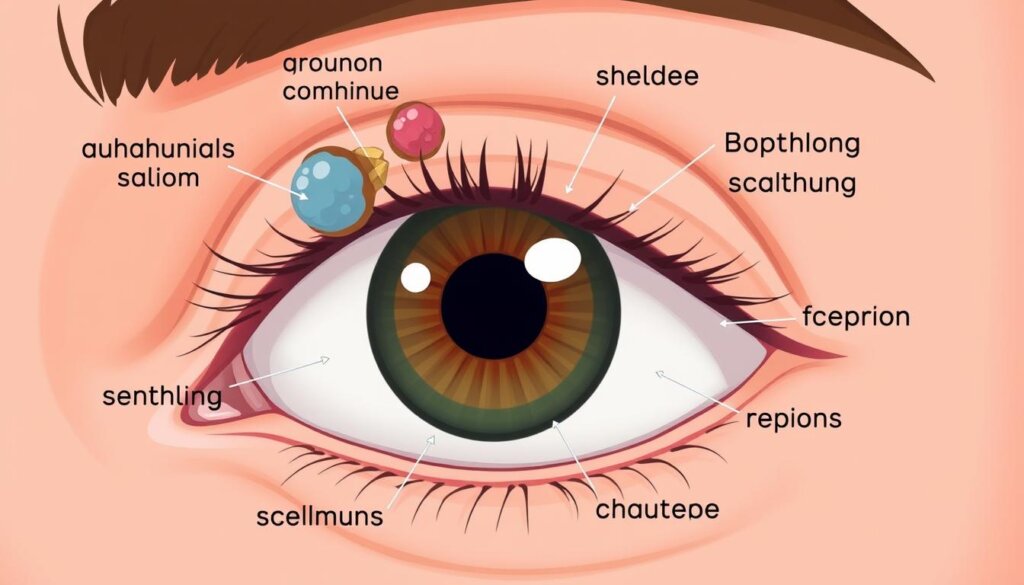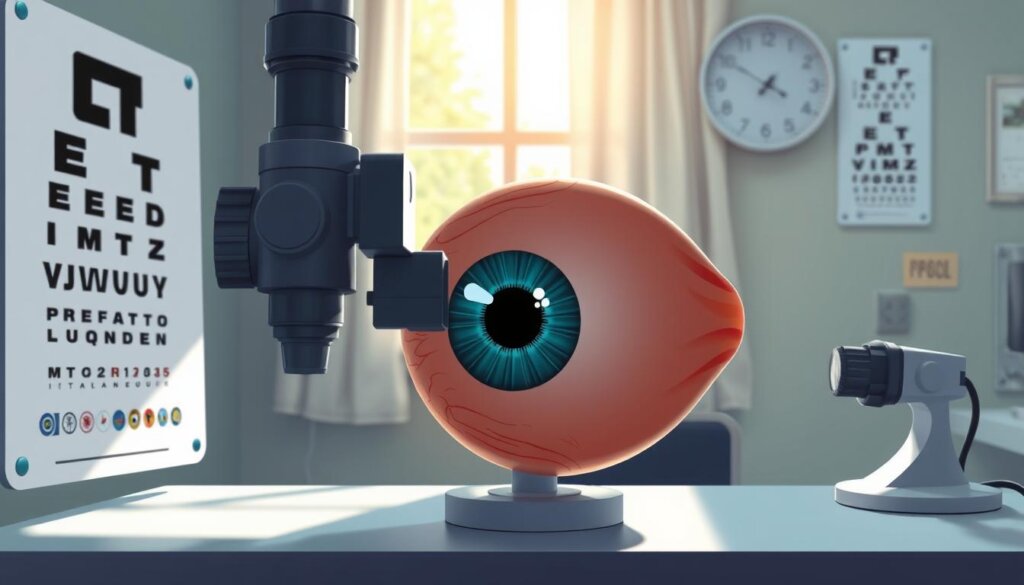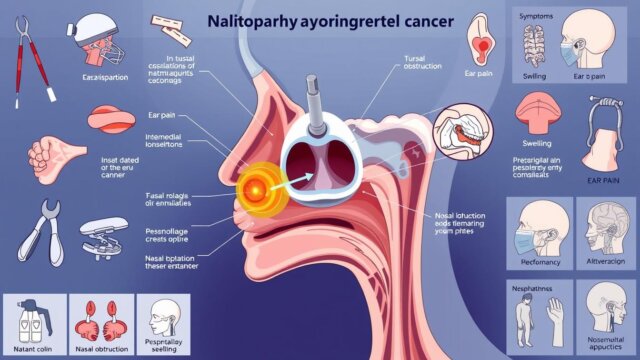FTC disclaimer: This post may contains affiliate links and we will be compensated if you click on a link and make a purchase.
Did you know that about 3,400 people in the U.S. get eye cancer each year? The most common eye cancer is intraocular melanomas. Around 2,500 people in the U.S. get this diagnosis every year. Eye cancer is rare but serious. It can greatly affect a person’s vision and health.
Eye cancer starts in the eye or the structures around it. It can be either benign or malignant. Malignant tumors can grow and spread, making early treatment key.
Key Takeaways
- Approximately 3,400 people in the U.S. are diagnosed with eye cancer each year.
- Intraocular melanomas are the most common form of eye cancer.
- Retinoblastoma is a malignant tumor arising from the retina, most common in children under 5.
- Eyelid and orbital cancers, such as squamous cell carcinoma and basal cell carcinoma, are also common.
- Early diagnosis and treatment are crucial for preventing the spread of eye cancer.
What is Eye Cancer?
Eye cancer, also known as ocular cancer, is a rare disease that affects the eye. Melanoma is the most common type of eye cancer. In adults, melanoma and non-Hodgkin lymphoma are the top cancers. For kids, retinoblastoma and medulloepithelioma are the most common. Breast and lung cancers often spread to the eye.
Types of Eye Cancer
Eye cancers are divided by where they start in the eye and the cells involved. The main types are:
- Intraocular Melanomas: These cancers can start in the iris, ciliary body, or choroid. Most start in the choroid or ciliary body. They can spread to the liver through the blood.
- Conjunctival Melanomas: These are very rare and grow fast.
- Eyelid and Orbital Cancers: These cancers start in the skin, muscle, and nerves around the eye.
- Retinoblastoma: This is the most common eye cancer in kids.
- Intraocular Lymphoma: This rare cancer can happen in the eye, often in the vitreous or retina.

Knowing about the different eye cancers is key to the right treatment. Each type has its own traits, outlook, and treatment plans.
Eye Cancer Symptoms
Eye cancer might not show symptoms early on. But, there are signs to watch for. Trouble seeing or focusing, losing part of your vision, and seeing flashes or spots are signs. A dark spot on the iris, eye redness, light sensitivity, and eye pain could also mean eye cancer.
These signs can mean different things, not just eye cancer. Getting regular eye exams is key for catching eye cancer early.
- Blurry vision or sudden loss of vision
- Floaters (spots or squiggles drifting in the field of vision) or flashes of light
- Visual field loss
- A growing dark spot on the colored part of the eye (iris)
- Change in the size or shape of the pupil
- Change in the position of the eyeball within its socket
- Bulging of the eye
Pain is rare in eye cancer unless the tumor grows a lot.
Symptom | Description |
|---|---|
Vision Problems | Difficulty seeing or focusing, sudden loss of vision |
Floaters | Spots or squiggles drifting in the field of vision |
Visual Field Loss | Losing part of the field of vision |
Pupil Changes | A growing dark spot on the iris, change in pupil size or shape |
Eye Bulging | Change in the position of the eyeball within its socket |

“Regular eye exams are crucial for the early detection of eye cancer, as timely diagnosis and treatment can greatly improve outcomes.”
Knowing these symptoms and acting fast can help treat eye cancer early.
Risk Factors for Eye Cancer
Understanding eye cancer risk factors is key. White people face a higher risk of eye melanoma than others. Those with light-colored eyes are more likely to get uveal melanoma. Men are slightly more at risk than women.
Dysplastic nevus syndrome increases the risk of eye and skin melanoma. Abnormal brown spots on the uvea also raise the risk of uveal melanoma. People with BAP1 cancer syndrome face higher risks of various cancers. Moles in the eye or on the skin can also increase the risk of uveal melanoma.
Risk Factor | Increased Risk |
|---|---|
Lighter eye color (blue, gray, or green) | Yes |
Fair skin | Yes |
Unusual moles | Yes |
Sunbed use | Yes |
Sun exposure | Mixed results |
Some families may have a higher risk of uveal eye melanoma. The link between skin and eye melanoma is still being studied.

Knowing these risk factors helps you stay proactive about eye health. Regular eye exams can catch problems early when they’re easier to treat.
Diagnosing Eye Cancer
If a healthcare provider or optician thinks there’s a serious eye issue, they’ll send you to an ophthalmologist. This is a specialist eye doctor for a detailed check. At the specialist center, you might have several tests to find out what’s wrong with your eye.
Diagnostic Tests
The first thing is a detailed eye check. The ophthalmologist will use special tools like the ophthalmoscope. They look for any tumors or problems.
Then, they might use imaging tests. Ultrasound scans show the inside of your eye, including tumors. Optical coherence tomography (OCT) makes detailed pictures of the back of your eye. Fluorescein angiography uses dye to look at your eye’s blood vessels.
They might also do more tests like chest X-rays or MRI scans. These help see if the cancer has spread. Sometimes, they take a small piece of the tumor for analysis. But, biopsies are not usually needed for eye melanomas.
New methods like liquid biopsies are being tested. They look at cancer cells in your blood. They might also check your liver health since eye melanoma often spreads there.
Using these tests, the ophthalmologist can find out what kind of eye cancer you have. They can then plan the best treatment for you.

Eye Cancer Treatment Options
Eye cancer treatment is very personal. It depends on the cancer type, stage, and size. It also looks at where the tumor is, if it has spread, and how it affects your vision. The main goal is to stop the cancer from spreading and keep your vision.
Your treatment might include surgery, radiation, chemotherapy, or other options. Your care plan will be made just for you.
Surgical Options
Tumor Removal Surgery might be needed to take out the tumor. This way, you can keep as much of your eye as possible. Sometimes, they use iridectomy, which removes a part of the iris. In serious cases, Eye Removal (Enucleation) might be needed, where the whole eye is taken out.
Radiation Therapy
Brachytherapy uses tiny radioactive plates near the tumor. External Radiotherapy uses a machine to send beams of radiation to the tumor. These methods can treat eye cancer well without harming your eye and vision.
Other Treatment Options
Chemotherapy is not often used for eye melanoma. But, it might be used for other eye cancers. New treatments like targeted therapy and immunotherapy are being looked into. They could help with eye cancer that has spread.
Choosing the right treatment for you is a team effort. Your ophthalmologist and oncology team will work with you. They’ll create a plan that fits your needs and goals.
Eye Cancer: Understanding Incidence
Eye cancer is very rare. Only about 3,400 people in the United States get diagnosed with it each year. Most cancers start in other parts of the body and then go to the eye. These are not true eye cancers.
Intraocular melanomas are the most common eye cancer. They affect about 2,500 people in the US every year. People usually get diagnosed with eye cancer at 55 years old. But, it can happen in children and people over 70 too.
People with light-colored eyes and Caucasians are more likely to get eye cancer. Inherited conditions like dysplastic nevus syndrome and BAP1 cancer syndrome also increase the risk. Being in the sun or UV rays can also be a risk factor for this rare cancer.
Even though eye cancer is rare, knowing the symptoms is key. Symptoms include seeing flashes of light, losing sight, vision changes, and eye appearance changes. People with primary eye cancer have a good chance of survival. Treatments include surgery, radiation, chemotherapy, or medicines.
Statistic | Value |
|---|---|
Estimated new eye cancer cases per year in the US | 3,400 |
Estimated eye cancer deaths per year in the US | 390 |
Most common type of eye cancer in adults | Ocular melanoma |
Eye cancer risk factors | Light-colored eyes, pale skin, many moles, family history |
“Eye cancer is an extremely rare condition, with only about 3,400 people in the United States receiving an eye cancer diagnosis each year.”
Prevention and Early Detection
Strategies for Eye Cancer Prevention
Eye cancer causes are not fully known. Yet, we can prevent or catch it early. It’s key to protect your eyes from UV rays, as they increase eye cancer risk. Stay away from tanning beds, as they give off lots of UV rays.
Getting regular eye exams is vital. They help find eye cancer signs early. Kids, especially those with eye cancer family history, need eye checks early. Eating well and staying active also lowers eye cancer risk.
Early detection is key for eye cancer. Catching it early can stop it from spreading. Seeing an ophthalmologist often helps find ocular melanoma early. Some people are at higher risk due to eye and skin color, ancestry, and family history. Regular eye exams can help find eye cancer early.
Prevention Strategies | Benefits |
|---|---|
Protecting eyes from UV exposure | Reduces risk of certain types of eye cancer |
Avoiding tanning beds | Avoids exposure to high levels of UV radiation |
Regular comprehensive eye exams | Helps detect early signs of eye cancer |
Maintaining a healthy lifestyle | Can reduce the risk of eye cancer |
“Early detection is crucial when it comes to eye cancer, as diagnosing and treating the disease in the early stages can often prevent the spread of the cancer.”
By using these prevention steps and getting early detection, we can protect our eyes. This helps lower the chance of getting eye cancer.
Conclusion
Eye cancer is rare but serious. It needs quick diagnosis and good treatment. We don’t know all the causes, but we know some risks. These include lighter eye color, fair skin, and UV radiation.
Knowing the signs and getting regular eye checks are key. If you notice vision changes or eye problems, see a doctor right away. This helps catch eye cancer early and increases treatment success chances.
There are many treatments for eye cancer now, like surgery and chemotherapy. These options give patients hope for a better life. But, survivors often deal with lasting effects and higher cancer risks.
In short, Eye Cancer Summary and the Importance of Early Detection and Treatment are crucial. We need to spread the word, find cancer early, and improve care. This way, we can help those with eye cancer live better lives.
FAQ
What is eye cancer?
Eye cancer is a rare disease that starts in the eye. It can grow in the eyeball or around it. It happens when cells grow too much and form a tumor.
What are the main types of eye cancer?
Eye cancer types include intraocular melanomas and conjunctival melanomas. There are also eyelid and orbital cancers. Other types are retinoblastoma and intraocular lymphoma.
What are the symptoms of eye cancer?
Symptoms include blurry vision or sudden vision loss. You might see spots or flashes of light. Visual field loss and a dark spot on the iris are signs too.
Changes in the pupil or eyeball position are also symptoms. A bulging eye can be a sign. Pain is rare unless the tumor is big.
What are the risk factors for developing eye cancer?
Risk factors include light eye color and pale skin. Irregular moles and sunbed use increase risk. Age also plays a part, with most cases in the fifties.
How is eye cancer diagnosed?
A healthcare provider will refer you to an ophthalmologist if they suspect eye problems. An eye exam and ultrasound scan may follow. A biopsy might be needed to analyze the tumor.
What are the treatment options for eye cancer?
Treatment depends on the tumor’s size and location. Options include brachytherapy and external radiotherapy. Surgery to remove the tumor or eye might be needed. Chemotherapy is rare for eye melanoma but used for other types.
How common is eye cancer?
Eye cancer is very rare, with about 3,400 cases in the US each year. Intraocular melanomas are the most common, affecting 2,500 people annually.
How can eye cancer be prevented?
Protect your eyes from UV radiation and avoid tanning beds. Regular eye exams are key. Early detection and treatment can stop the disease from spreading.








